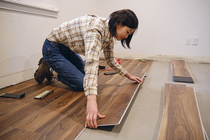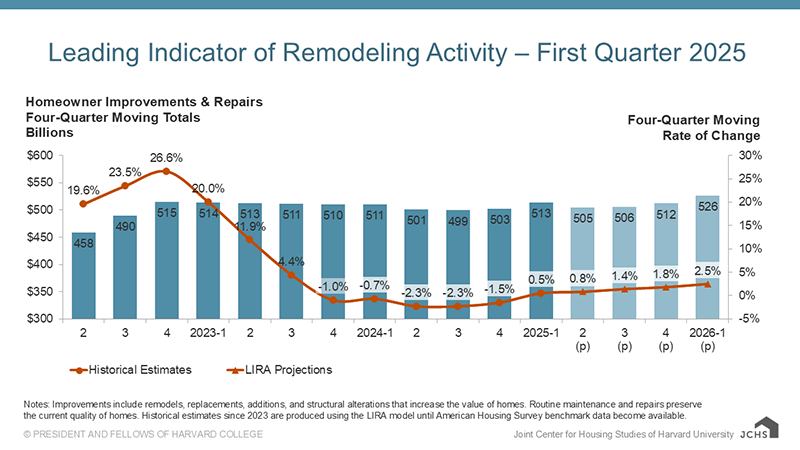Continued Gains Projected for Remodeling Amid Economic Uncertainty

CAMBRIDGE, MA – Annual expenditures for improvements and maintenance to owner-occupied homes are expected to grow modestly through 2026, according to the Leading Indicator of Remodeling Activity (LIRA) released today by the Remodeling Futures Program at the Joint Center for Housing Studies of Harvard University. The LIRA projects that year-over-year spending for home renovation and repair will increase by 2.5 percent to reach a record $526 billion by the first quarter of 2026.
“A slight downturn after the pandemic’s record expenditures gave way to modest gains in the sector this year,” says Carlos Martín, Director of the Remodeling Futures Program at the Center. “Recent increases in the sales of existing homes are expected to drive slow but steady growth in home remodeling and repair.”
“So far, high home values and other strong economic indicators have supported an uptick in homeowner improvement spending,” says Chris Herbert, Managing Director of the Center. “However, economic volatility due to the uncertainty surrounding foreign tariffs and falling consumer confidence could well dampen this expected growth.”
Click image for full-size chart.
The Leading Indicator of Remodeling Activity (LIRA) provides a short-term outlook of national home improvement and repair spending to owner-occupied homes. The indicator, measured as an annual rate-of-change of its components, is designed to project the annual rate of change in spending for the current quarter and subsequent four quarters, and is intended to help identify future turning points in the business cycle of the home improvement and repair industry. Originally developed in 2007, the LIRA was re-benchmarked in April 2016 to a broader market measure based on the biennial American Housing Survey.
The LIRA is released by the Remodeling Futures Program at the Joint Center for Housing Studies of Harvard University in the third week after each quarter’s closing. The next LIRA release date is July 17, 2025.
The Remodeling Futures Program, initiated by the Joint Center for Housing Studies in 1995, is a comprehensive study of the factors influencing the growth and changing characteristics of housing renovation and repair activity in the United States. The Program seeks to produce a better understanding of the home improvement industry and its relationship to the broader residential construction industry.
The Harvard Joint Center for Housing Studies strives to improve equitable access to decent, affordable homes in thriving communities. We conduct rigorous research to advance policy and practice, and we bring together diverse stakeholders to spark new ideas for addressing housing challenges. Through teaching and fellowships, we mentor and inspire the next generation of housing leaders.
MEDIA CONTACT:
Kerry Donahue, Director of Communications
(617) 495-7640, [email protected]

